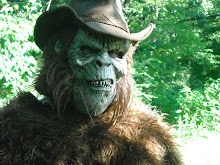|
Facts:Activity: Damage: Inhabits: Cycle: Year round Noises:
|
The Skunk
Characterized by their conspicuous black and white markings and use of a strong, highly offensive odor for defense. The scent glands of skunks produce an oily, yellowish liquid, which the animal squirts with great force from vents under the tail; this produces a fine mist which, in addition to stinking, causes choking and tearing of the eyes. Skunks do not make use of this weapon unless severely provoked and then only after raising the tail in a warning display. Most animals quickly learn to recognize and avoid skunks, which are consequently quite fearless and move about openly. The two common skunks of the United States, the striped skunk and the spotted skunk, are nocturnal animals; their diets include rodents, insects, eggs, carrion, and vegetable matter. They live, often several individuals or families together, in dens made in abandoned burrows or buildings or in rock piles. Most familiar is the striped skunk, Mephitis mephitis, of the United States, N Mexico, and Canada S of Hudson Bay. It has thick black fur, usually with two white stripes on the back. It is 13 to 18 in. (33–46 cm) long, excluding the bushy tail (7–10 in./18–25 cm), and weighs 6 to 14 lb (2.7–6.4 kg). Because it destroys pests, it is protected in many states. In northern parts of their range the animals sleep through much of the winter, but they do not truly hibernate and may emerge during warm spells. The small, slender, spotted skunk, Spilogale putorius, has several irregular white stripes or lines of spots. It inhabits Mexico and the W, S, and central United States. Its combined head and body length is 9 to 13 in. (23–33 cm) and the tail is 4 to 9 in. (10–23 cm) long. This skunk balances on its front paws as part of its warning display.

Animal control, animal removal georgia, animal trapping georgia, wildlife control georgia, wildlife removal georgia, wildlife trapping georgia, Gray Squirrel Removal georgia, Gray Squirrel Trapping, Gray Squirrel control, Gray Squirrel Trapping, flying Squirrel Trapping Georgia, flying Squirrel control, flying Squirrel removal, bat removal, bat control, bat exclusion, beaver trapping, beaver removal, beaver control georgia, Rat trapping, rat removal georgia, rat control, raccoon trapping georgia, raccoon removal, raccoon control, coyote trapping georgia, coyote removal, coyote control, opossum trapping, opossum removal georgia, opossum control, fox control, fox trapping georgia, fox removal georgia, bird control georgia, bird exclusion georgia, mole control georgia, muskrat trapping georgia, muskrat removal, snake removal georgia, homey bee removal georgia, honey bee control, carpenter bee removal georgia, carpenter bee control, wasp removal georgia, wasp control, hornet control, hornet removal georgia, yellow jacket removal, yellow jacket control georgia, animal damage repairs and exclusion, dead animal location removal georgia. Honey bee nest removal, hornet nest removal, rodent removal, how to remove bats, how to remove squirrels, critter control, critter removal.
We Service: North Fulton county, Cherokee conty, Forsyth county, Dawson county, Pickens county, Gilmer county, Lumpkin county, Hall county, Gordon county, Murray county, Fannin county, Roswell, Alpharetta, Woodstock, Cumming, Atlanta, Flowery Branch, Suwannee, Oakwood, Gainesville, Ball Ground, Canton, Milton, Blue Ridge, Cherry Log, Ellijay, Duluth, Buford, Talking Rock, Waleska, Jasper, Dawsonville, Big Canoe, Dahlonega,


No comments:
Post a Comment